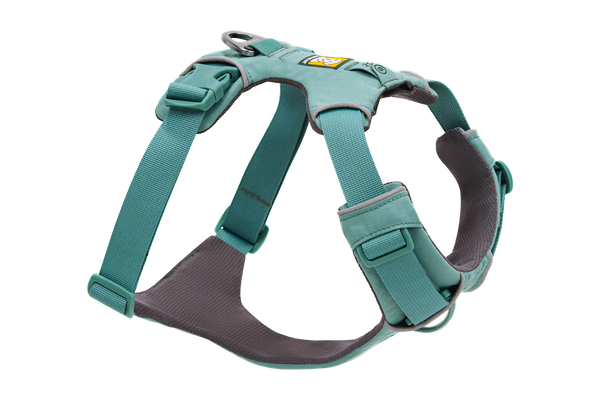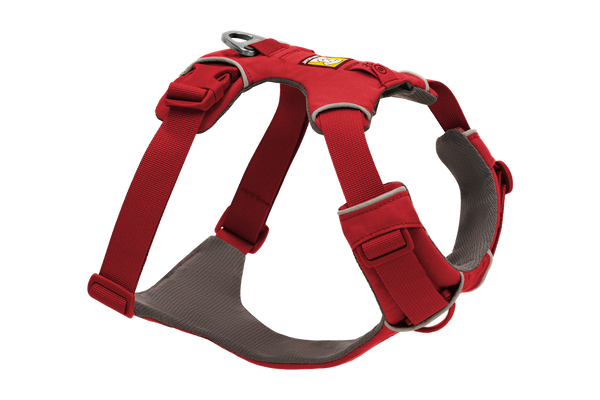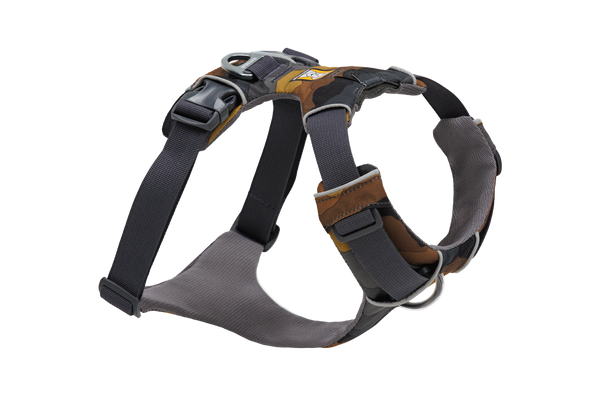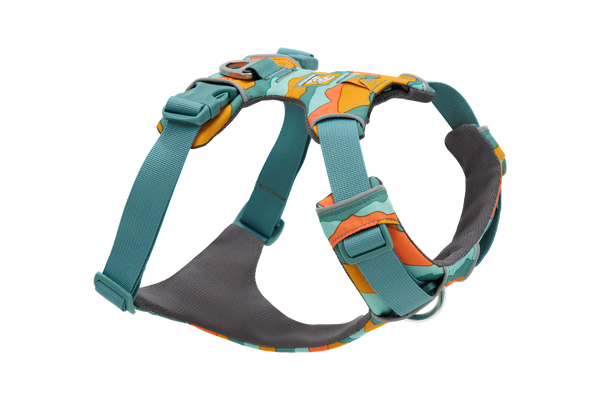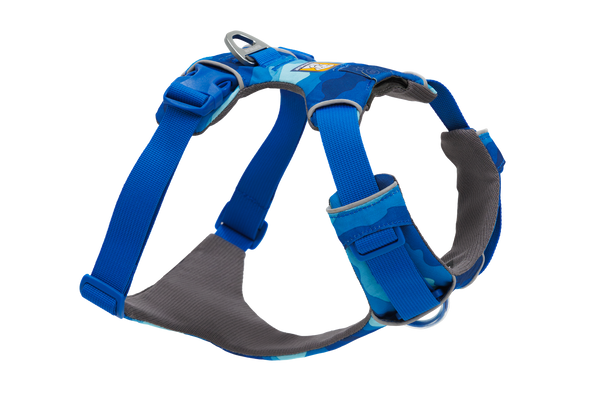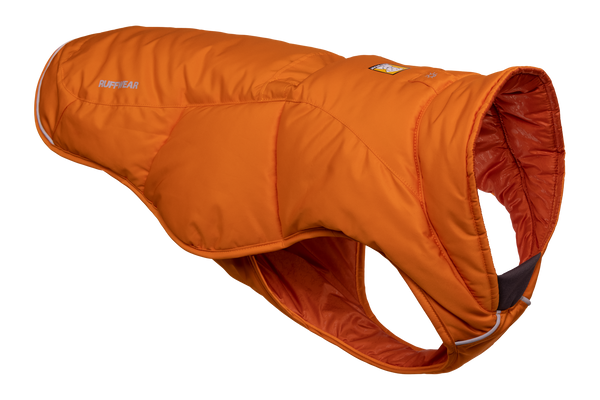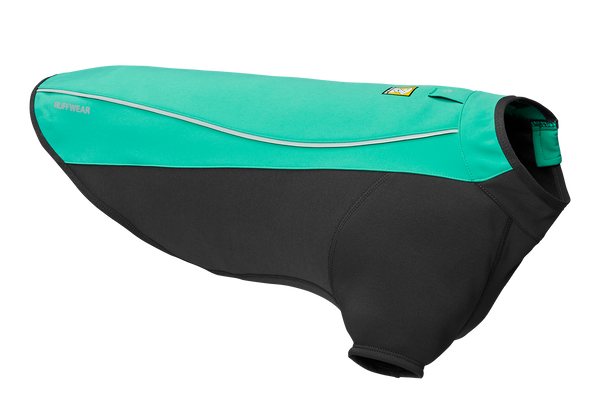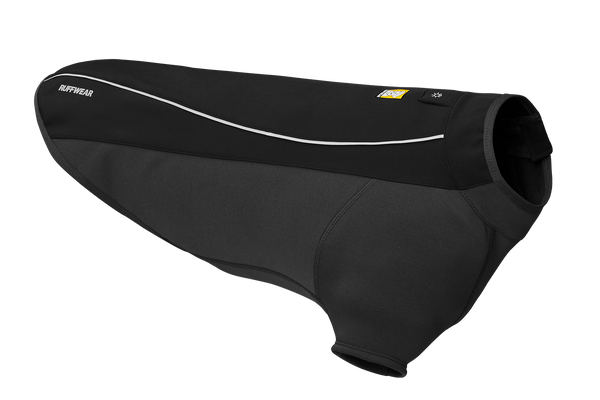Waffle the Working Dog: A Tale of Triumph
Kate Speer, a Ruffwear ambassador, mental health advocate, and writer lives in Vermont with her husband Dave, service dog Waffle, and her service dog in training Tugboat who is following in Waffle’s footsteps with big paws to fill. To read more about her experiences recovering from serious mental illness and get updates about her forthcoming memoir, sign up for her bestselling Substack here – katespeer.substack.com – or follow her on Instagram at @wafflenugget and @kate_speer.
Editor’s note: This post discusses suicide and mental illness.
I remember the moment my doctor told me that I would only survive in a locked psychiatric ward like it was yesterday. I was sitting at the head of the table in the care team’s narrow office. Crowded in front of me were three doctors, three nurses, and two therapists, most of whom had spent the last ten years fighting to help me manage my suicidality, extreme mood lability, and intermittent psychosis. These were the people who had worked with me to try every evidence-based treatment psychology and psychiatry had invented to manage my serious mental illness and 21 inpatient stays. But that day, as the doctor uttered those words – Kate, this is the end of the road. Your illness is too severe to live freely – they gave up on me and didn’t even have the decency to look me in the eyes as they did so.

I think about it often — how I was treated more like a specimen than a human being that day, and as much as I hold space for their very human shame, sorrow, and anger at the severity of my illness that day, I still keep suffering from it. I still keep aching to be seen in my capacity, however different. And I still keep struggling with the reality that moment brought to life. Perhaps it's no surprise then, that after that meeting, after the plans for residential locked inpatient care were shared, I refused to listen to them and I set out to prove them wrong with the help of a dog.

Back then, being ten years ago before social media normalized mental health and service teams, I never set out to have a service dog. I merely set out to survive my illness and the system that had failed me by finding companionship in my invisible madness. Of course, that sounds like a line from a movie but I promise you – it really isn’t one. Ten years ago, so disabled by intermittent psychosis and PTSD so severe it induced chronic incontinence, all I wanted was to maintain my ability to live outside a hospital.
So, motivated to try anything I could to maintain my independence, my partner Dave and I brought home an adorable Bernese Mountain Dog puppy to keep me company in my illness. A ten-pound ball of sassy fluff, she joined us on Valentine’s Day in the middle of a blizzard and we named her Waffle Ellis Lutz.

Photo: Waffle’s second day home.
Now, I won’t pretend that getting her didn’t create a total mess at first. Puppies are hard – so very hard. But amidst the chewed table legs, my parents stepping in for sleep duty, and my care team increasing my medications, the most amazing thing happened. Waffle started to hurl herself upon me and comfort me whenever I had panic attacks or severe anxiety from my hallucinations.
When this cute puppy who chewed drywall, howled all night, and could barely sit on command started hurling herself upon me when my body dysregulated from the hallucinations, it seemed more like absolute happenstance. But after two weeks of these “fluff bombs” happening, I knew this wasn’t just a mere coincidence. I knew it was something special – something I had been searching for since I first experienced the depths of terror and paranoia psychosis induced a decade earlier – someone I could trust to be there with me and support me in my terror and madness.
When I proudly shared with Dave that Waffle was going to solve “all of my problems” by supporting me in my symptoms, he kindly pet me on the head like the goofy puppy I embodied, sweetly placating my dire belief that this adorable monster of ours was the solution to the serious mental illness that had almost landed me in a locked ward for life. But his kind dismissal did not dissuade me. I had already been told I was doomed for psychiatric confinement and dismantled that fate, so I set out to prove him wrong and cement the “fluff bombs” and snuggles into actual reassurance which I could trust.
Back then, so disabled I was only working four hours a week, I had ample time to devote to training Waffle. So like the nerd I am, I researched everything I could find about the human body in times of stress, dogs’ olfactory capacity, disability rights, Temple Grandin’s deep pressure technique, and how narcotics dogs were scent-trained. I learned about elevated cortisol and how humans emit it in their sweat during times of stress. I learned that dogs have 300 million olfactory receptors in their noses compared to about six million in humans, and that deep pressure therapy has been proven to reduce the stress response in all mammals. I also learned how narcotics dogs were trained with two samples – one target scent of the drug and another scent that served as the control.

Photo: Practicing alerts in the driveway
Cobbling together what I had learned and the limited “mark and reward” lessons I had picked up in Waffle’s puppy obedience class, I haphazardly built my own training plan and set out to teach Waffle how to smell, alert, and lie upon me in deep pressure therapy whenever I had a panic attack and fear response due to my hallucinations. To do this, I first taught her how to give me a paw on cue. Then I devised my own scent-training protocol in which used a panic attack sweat-soaked t-shirt in a Ziploc bag as the fear scent sample and a workout t-shirt for the control scent sample. I mixed opening the two Ziploc bags and rewarded her for giving me a paw when she correctly alerted for the fear scent. I also mixed in using the t-shirts out of the bag to make sure she wasn’t alerting for the action of opening the bag.
Though our training was built on sound science and I lovingly named the whole thing “the bacon protocol” in honor of the ten pounds of bacon I had bought at a Vermont farmstand to reward her with, the whole thing was nowhere near as organized or formal as it now sounds. But Waffle loved it, so we practiced every day, and what we lacked in experience and structure, we made up for in enthusiasm and commitment.
Day after day, when my symptoms were in check, we would practice. I’d open the fear scent bag and Waffle would give me a paw. Then, I’d reward her with bacon. Within a week, she could tell the difference between the two scents and paw accordingly. And after we practiced every day for a month, she would come running from anywhere in our cabin to alert me and offer deep pressure therapy when I had a panic attack or fear response upon seeing hallucinations.

Photo: Waffle in deep pressure therapy position
Once Waffle had mastered paw alerts and deep pressure therapy in the house, I started training Waffle outside, and after another month of training, Waffle would come running anytime I had a panic attack or opened the heightened cortisol bag in the woods to alert me, no reward needed. I remember the joy of those early adventure alerts vividly – the beaming pride on Waffle’s face and the astounded glee I felt at the absolute miracle of this dog’s skill.

Photo: Waffle – mid-paw alert outside
The feeling of astonishment only grew from there. With every paw and deep pressure therapy snuggle Waffle gave, I trusted her more and more. And day by day, with her by my side, I began to trust our partnership enough to venture out into the world beyond our cabin and short walking trail. Over the course of the next year, I public access trained Waffle and thereafter, I trained her in additional tasks too – blocking, night terror interruption, alerting for visitors, grounding assistance and more. We spent more than fifteen hundred hours training together and every single second was worth it because with her newfound skills and partnership, my life completely transformed.

Over the years, Waffle has gotten me off of disability and taken me all over the country – to New York to run a start-up, to the altar to marry Dave, to Boston to teach at Harvard, and to countless adventures worldwide with friends and family that I had once lost to my illness. But more than that – more than any achievement society might deem impressive, the most amazing thing Waffle did was give me back my humanity. Yes, a dog – my dog – my beloved service dog gave me back my humanity because she lives the truth we all hold the power to know and live.
She looks my pain in the eye and says, I see it. It matters. I am here with you and I will stay and fight until we make it better together.
And though such an act will never be a service dog task or make headlines in the New York Times, today, let it be enough and let it serve you so others like me no longer sit invisible and alone in their hidden fight.

If you’re experiencing mental health struggles or suicidal ideation, there are people who’ve been there, and are ready to help. Here are some resources.
- National Suicide Prevention Lifeline (US): 988
- Crisis Text Line (US): Text HOME to 741741



